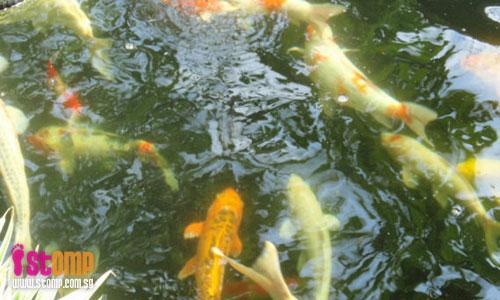
Saturday, January 31, 2009
Tampines bush fire so huge, it can be seen from Eunos

STOMPer Jeremy says this fire on a forested plot of land in Tampines was so huge, it could be seen by his friend staying in Eunos.
Jeremy said:
"A fire occurred in front of an empty forested plot of land just across the road of Block 714, Tampines Ave 9 at around 4pm on 30 Jan 2009.
"The inferno was quite big, and the smoke generate from it was enormous.
"According from my friend who stays near Eunos area, the columns of brown smoke generated from the fire could be seen from his upper floor flat, more than 10km away.
"My location was nonetheless at the heart of the disaster zone, barely metres across the road from the inferno ground where the fire had destroyed the land slightly larger than the size of a football field.
"I was woken up abruptly from my afternoon nap by the choking smell of the burning trees.
"Upon looking out of the window, I realised that I was surrounded by a thick layer of smoke.
"The next block was barely visible. I know instinctively where the choking smoke could have come from.
"And the likely source was the forested area just metres from my block due to the dry weather season that I had long suspected might have ignited the fire.
"The visibility of the whole neighbourhood and the roads (Tampines Ave 9, Ave 6 and part of Ave 5) directly in the path of the thick black smoke was almost close to zero.
"The heat was intense, bright skies turned into evening and the heat could even be felt across the road where the ferocious fire was raging.
"The fire got stronger and stronger with the help of the North-East strong wind which seemed to be blowing toward the South."
SCDF says it received a call at 4.34pm informing them of a bush fire on a plot of land located at the junction of Tampines Avenue 6 and Avenue 9.
Three fire engines, one red rhino, one tracked fire-fighting vehicle and three support appliances were deployed to the scene.
SCDF arrived at the scene within six minutes.
It says the fire involved overgrown shrubs across an area one and a half the size of a football field.
The fire was extinguished within one hour using six water jets.
No one was injured.
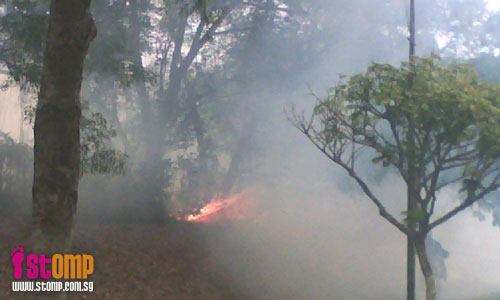

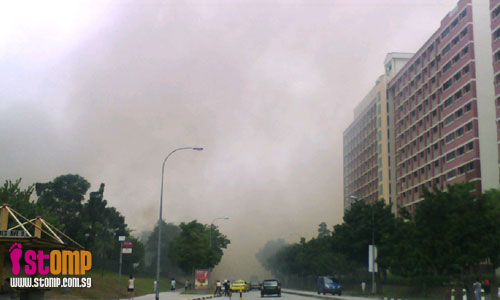
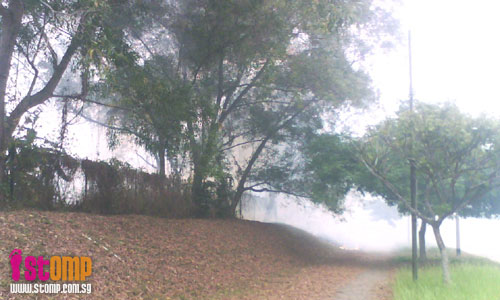
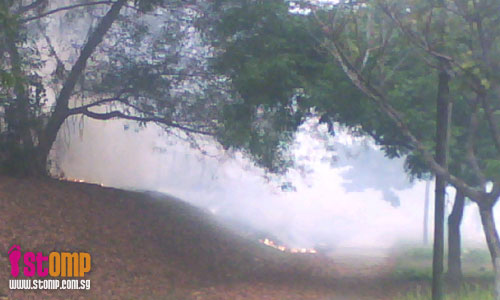

Go here for relevant news articles and related Seen on STOMP posts on bushfires in Singapore
I had no idea there was a bush fire in that part of Tampines yesterday, especially since I live quite nearby, and my workplace is also situated quite close to where the fire occurred. At the time of the fire, I was occupied with other matters in another corner of Singapore, so unfortunately, I missed the chance to watch the smoke from my workplace.
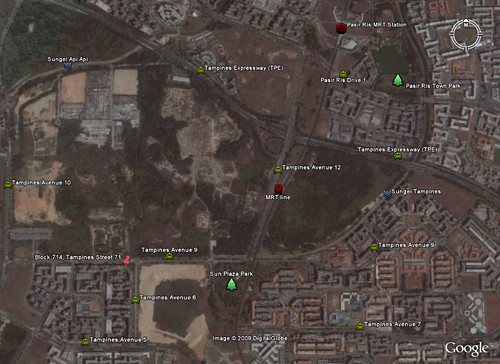
(Click here for original size)
Here's a view of the affected area on Google Earth, showing part of Tampines and Pasir Ris. Block 714 is indicated, as are major roads. You can also see the MRT line between Tampines and Pasir Ris Stations, a couple of parks, and the upper reaches of Sungei Api Api and Sungei Tampines. Also, take note of the large expanse of open land bound by Tampines Avenue 10 on the left, Tampines Avenue 12 on the right, Tampines Avenue 9 at the bottom, and the Tampines Expressway (TPE) on top. I have not personally gone down to check out the site, but this is likely to be where the fire took place. Oh, any by the way, my home and my workplace happen to be somewhere inside this image as well.
When I was 14, and living just along Sungei Tampines, a bush fire broke out in the forested area opposite my block. In the satellite image, that's the slightly smaller, almost triangular piece of open land bound by the MRT line on the left, the concretised portion of Sungei Tampines at the bottom, and the TPE on top. I can't recall if it occurred during the drier months, but it did produce quite a lot of smoke, and it took some time before the firefighters were able to put the fire out. The burned mixture of scrub and grassland remained charred and blackened for some time, and it took at least a couple of years before the regrowing vegetation completely covered all traces of fire.
Many native species inhabit these areas of scrub and grassland, from wildflowers to birds, and it is unfortunate that most of these patches are considered to be of little conservation value. In 2005, a particularly bad spate of bushfires led to the publication of this article in the local papers, about the possible threat to native fauna and flora found in these habitats.
These patches of wasteland are covered with a mixture of scrub, grassland, and Adinandra belukar, and feature a mixture of both native and non-native plant species. In low-lying areas, the ground becomes waterlogged, creating marshes. I have not really intensively explored these areas, but I did make a few forays many years ago when I was in secondary school, only to be stopped in my tracks by forbiddingly impenetrable tangles of lalang (Imperata cylindrica) and giant mimosa (Mimosa pigra).
Although such man-made patches of secondary vegetation might seem impoverished in terms of biological diversity as compared to primary rainforest, The Natural Heritage of Singapore does have some very interesting things to say about them:
"In contrast to primary vegetation, which is in equilibrium with the physical environment of the site, secondary vegetation undergoes ecological succession, a process of continuous, uni-directional change (Corlett, 1991b). In theory, if an area of primeval vegetation is cleared, a series of different vegetation types will succeed one another at the site, culminating in the restoration of the primeval vegetation type originally there if these conditions are met: the physical environment is not irreversibly altered and the constituent species have not become extinct.
In many parts of Singapore, unfortunately, the physical environment has been changed permanently, particularly in the topography, drainage patterns as well as elimination of the original primeval vegetation is not possible without intensive human intervention. Renewed or regular disturbance also reverses any succession towards its endpoint."
In other words, in the past, any land cleared for farming and development and then abandoned, would have eventually reverted to tall secondary forest given enough time. However, because of repeated clearing and disturbance, and the way in which human activity has significantly altered the environment, it is difficult or impossible for the original forest species to recolonise and recreate the original habitat.
Fire has an important part to play, since many of the dominant plant species found in secondary vegetation in Singapore are fire-tolerant or fire-resistant to some degree. For example, lalang dominates some areas, almost to the exclusion of other plants, because its underground rhizomes enable it to survive fires which destroy the shrubs and trees that sprout in these grasslands. Similarly, while Adinandra belukar is normally eventually replaced by tall secondary forest, fire prevents the trees characteristic of tall secondary forest from re-establishing themselves. And so Adinandra belukar forms a new final stage in the process of ecological succession, creating a fire climax habitat.
If anyone is interested in finding out more about how Singapore's natural vegetation has been changed and altered over the years, I highly recommend the following:
- R.T. Corlett, 1991a. Plant succession on degraded land in Singapore. Journal of Tropical Forest Science, 4(2): pp. 151-161.
- R.T. Corlett, 1991b. Vegetation. In: Chia Lin Sien, Ausafur Rahman & Dorothy Tay (eds.), The Biophysical Environment of Singapore. Singapore University Press: pp. 134-154.
- R.T. Corlett, 1992. The Ecological Transformation of Singapore, 1819-1990. Journal of Biogeography, 19(4): pp. 411-420.
- J.W.S. Sim, H.T.W. Tan & I.M. Turner, 1992. Adinandra belukar: an anthropogenic heath forest in Singapore. Plant Ecology, 102(2): pp. 125-137.
- H.T.W. Tan, L.M. Chou, D.C.J. Yeo & P.K.L. Ng, 2007. The Natural Heritage of Singapore. Prentice Hall.
- Y.C. Wee & R.T. Corlett, 1986. The City and the Forest: Plant Life in Urban Singapore. Singapore University Press.
Labels:
falling trees,
fire,
haze,
introduced species,
pollution,
STOMP,
Tampines,
threats
Friday, January 30, 2009
Overgrown tree blocks pavement, inconveniencing pedestrians
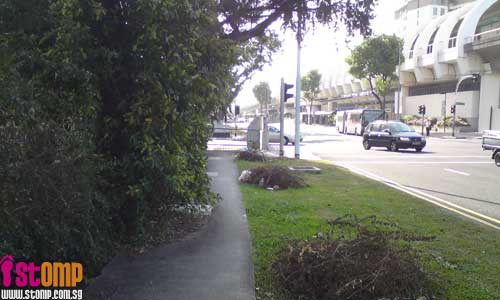
This overgrown tree blocks the pavement near Kembangan MRT Station, leaving only a narrow space for pedestrians to walk through.
STOMPer Pedestrian says:
"This picture was taken outside a private house which is located next to the pavement near Kembangan MRT Station.
"There are many trees and bushes outside this house.
"In mid Jan 2009, there was a trimming done. However, the tree in the centre of this picture was not trimmed.
"Pedestrians are obstructed by the tree when walking on the pavement.
"It is not too difficult for adults to avoid the tree, but for young children and people with prams, it is very difficult to walk past it.
"I would like to know whether this tree can be trimmed for the safety and convenience of the pedestrians?
"Should this be done by the relevant authorities or the house owner?"
This tree has claimed a bridge of its own
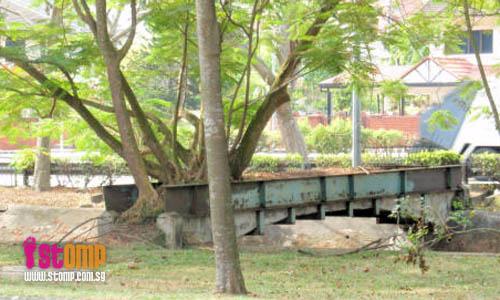
This old bridge built to cross a large drain in the Bukit Timah area has become occupied by a large tree, which has sunk its roots into the metal and concrete of the structure.Related post: Tree growing on old shophouse may cause pillars to give way (2nd February 2009)
Here's what the STOMPer had to say:
"This bridge joins Dunearn Road and Bukit Timah Road opposite Cherry Avenue.
"Part of the bridge is now occupied by a big tree which has sunk its roots into the bridge.
"The tree uses the bridge as a base support.
"One day when the tree has grown too big the bridge may well collapse and the tree will also end up in the canal below.
"Unbeknownst to the tree, its days are already numbered."
Viewing this post, I'm somehow reminded of an iconic tree, the sacred fig (Ficus religosa) that sprouts at Ta Som in Angkor, Cambodia.
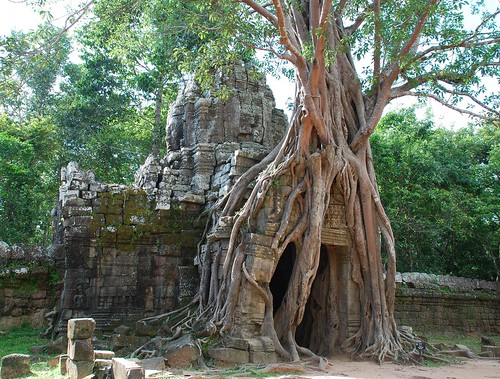
(Photo by bzeni)
In our equatorial climate, plants quickly take root in our concrete structures. Whether it's weeds sprouting up from the pavement, or saplings growing on buildings, I can't help but think about what it would be like if one day, humans were to suddenly vanish from the Earth. What would happen to our buildings, our bridges, our achievements in engineering and construction? I wonder if your average HDB block or Shenton Way tower is built to last as long as the ancient Mayan temples or Angkor Wat. Will Suntec City remain standing as the rainforest returns?
I highly recommend The World Without Us by Alan Weisman. It takes a very interesting look at how the world might change should we suddenly disappear one day. Although the forces of nature will quickly destroy and bury much of the signs of our civilisation, there are certain things that probably will linger, hinting at the former existence of an intelligent species that in the end, was still beholden to the forces that drive the never-ending processes of evolution and extinction.
Labels:
Bukit Timah,
STOMP,
trees
Thursday, January 29, 2009
Bird droppings everywhere because of too many pigeons
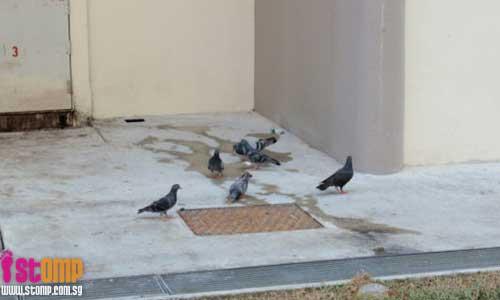
Bird droppings can be seen everywhere at Ghim Moh Estate due to the burgeoning pigeon population there.
According to a STOMPer, hordes of pigeons can be seen every day rummaging through bins.
He says:
"This picture was taken at Block 2, Ghim Moh Road.
"You can see many pigeons in this estate. Every day, I see hordes of pigeons rummaging through the bins.
"Some residents leave bags of leftover food near the waste bin area and when the pigeons eat the food they will leave a trail of food remnants which would later attract rats to this area.
"You can also see bird droppings on the floor, the parapet and even on bamboo sticks used to hang the laundry.
"If nothing is done, I fear the pigeon population here will soon outnumber the human population."
Related post: Neighbour always leaves food for birds! (21st January 2009)
Uncle feeds pigeons despite 'No Feeding' sign at Bencoolen Street (22nd January 2009)
Crazy pigeon is not afraid of people and steals food from their plates (23rd January 2009)
For some reason, pigeons are getting a lot of attention on STOMP lately.
While I think the person who submitted this is exaggerating (the small flock in the photo can hardly be considered a 'horde' of pigeons), it is true that feral pigeons (Columba livia) can become a serious nuisance in urban areas, and threaten the cleanliness and hygiene of a neighbourhood.
However, as hinted at in the post, this problem is partly a result of human behaviour. If leftover food was properly disposed of, the amount of food available to these birds would be greatly reduced, and also reduce the risk of attracting vermin.
Pigeons can be extremely prolific, since they reach sexual maturity at a young age, and can breed several times in a single year. The wild form of the pigeon, known as the rock pigeon or rock dove, tends to nest on cliff ledges. In urban area, the proliferation of man-made cliffs in the form of high-rise buildings has been to the feral pigeons' benefit. A number of strategies have been employed to keep pigeons away from buildings, or to prevent them from selecting certain spots as breeding sites, with varying amounts of success.
I still like to hope that one day, we will get to see peregrine falcons (Falco peregrinus breeding in urban Singapore, feeding on the flocks of pigeons like their counterparts in so many other cities around the world. Not very likely, I know, but one can always hope.
Oh, and if that little flock is considered a 'horde' of pigeons, I wonder what that person would have to say about natural spectacles such as this:
European starlings (Sturnus vulgaris), England
Red-billed quelea (Quelea quelea), Zimbabwe
And of course, who can resist thinking of Alfred Hitchcock whenever the subject of large flocks of birds is brought up?
Dead fish clog this waterway near Toa Payoh flyover

A STOMPer was told her sister had noticed a foul odour while waiting for a bus in front of Block 161 Toa Payoh near the flyover. She soon discovered a nearby waterway was full of dead fish.
Here's what she had to say:
"I took these pictures today (Jan 29) at about 9.30 am.
"While waiting for a bus my sister had noticed a rotting stench. For a moment she had thought there might have been a dead body nearby!
"She looked into the nearby waterway and discovered workers clearing the area of dead fish.
"A worker nearby told me that the the problem was happening all along the waterways in the area, from Thomson to Towner Road, and even all the way to the Geylang area.
"It seems all of the fish that are dying are also of the same species.
"I wonder what the source of the pollution is. There appears to have been construction nearby, maybe that's the cause of the problem."
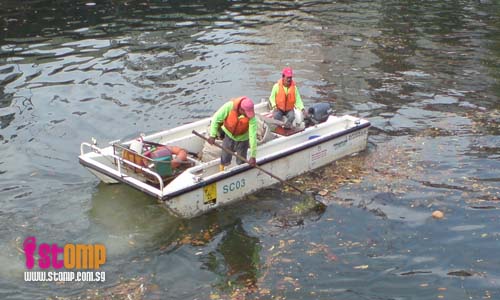

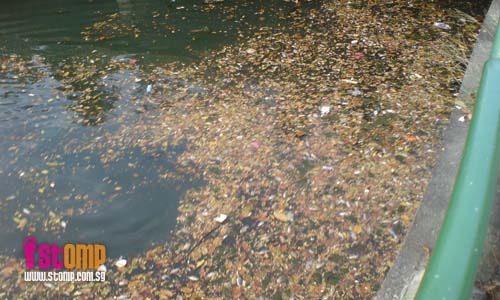

So much for the Public Utilities Board (PUB) and its ABC Waters Programme...
The fish involved appear to be tilapia (Oreochromis spp.), of which 3 species are known to occur locally; these are the blue tilapia (Oreochromis aureus), Mozambique tilapia (Oreochromis mossambicus) and Nile tilapia (Oreochromis niloticus). These species are also known to hybridise with one another, both in captivity and in the wild. In fact, the popular red tilapia that is bred on fish farms throughout the region is a hybrid between the Nile tilapia and Mozambique tilapia. Originally native to much of Africa, and parts of the Middle East, various species of tilapia have been introduced for aquaculture and fisheries throughout the tropics, and have established populations in every continent except Antarctica.
Ordinarily, these fish are extremely hardy, able to survive in our urban waterways. They thrive even in concretised monsoon drains and canals, habitats which present very harsh living conditions that most of our local fish cannot cope with. However, there are occasions when entire shoals of tilapia suddenly die en masse, which is a cause for concern, since these incidents may indicate that the cleanliness of our waters has been compromised.
The cause of this particular mass death could be due to various reasons. I think it is likely that for one reason or another, the waters underwent hypoxia, killing the fish. As to what triggered the depletion of dissolved oxygen, one can only guess. Possible causes include hot weather, or eutrophication due to an overabundance of algae or phytoplankton. There might be pollution, which would be quite serious if it is capable of killing tilapia in large numbers. Finally, it is possible that there is a virulent disease or deadly parasite sweeping through the tilapia population in the area. Without any actual analysis of the water, it is difficult to extrapolate further.
What worries me is that the area affected is situated relatively close to our Central Catchment Area. Also, it is drained by the Kallang River, which flows into the newly-completed Marina Reservoir. If pollution is the cause of this die-off, it does have serious implications for the management of our water supply. At this point, the former mouth of the Singapore River is still undergoing the transition from brackish water to freshwater, but in future, if pollution occurs upstream, it could contaminate the entire reservoir. It is essential to bear in mind that any form of pollution occurring at any point along the Kallang River and Singapore River could affect the entire reservoir.
I think the most likely scenario was that this die-off was more due to natural causes, a spell of hot weather and consequently low dissolved oxygen content making the waters temporarily inhospitable to aquatic life. Even so, the importance of safeguarding the health and cleanliness of our watersheds simply cannot be overstated.
Update: Mystery over dead fish in canal (30th January 2009) (Mirror)
Related post: Why so many dead fish in Rochor River? (10th February 2009)
Wednesday, January 28, 2009
Are they illegally dumping at the Mandai Road area?

STOMPer G sent in these pictures of copper slag being offloaded at Mandai Road and wondered if it was illegal to do so, as it is a water catchment area.
In an email to STOMP, the STOMPer sent in these pictures which he snapped on Jan 12 and wrote:
"Why is copper slag being offloaded at Mandai Road?
"Isn't Mandai a water catchment area - will there be a danger of slag seeping into water supply?
"Perhaps the authorities should comment on this."
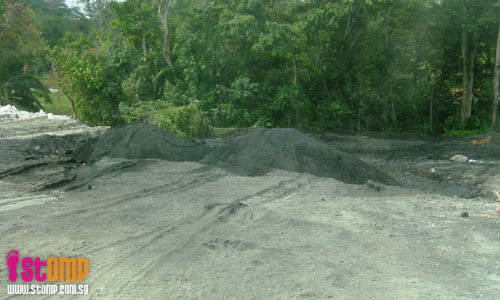
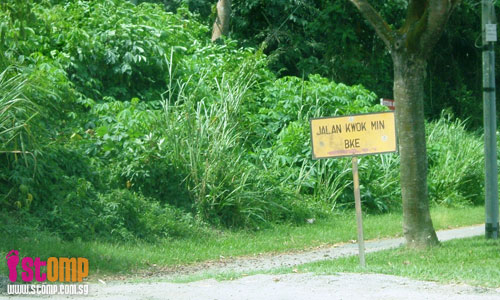

Wait a minute... this looks a little familiar.
Dead leaves dangling from palm tree can crack your skull!

A STOMPer says the dead leaves dangling dangerously on this palm tree near Sim Lim Square can crack someone's skull if they were to suddenly fall off.
He says:
"These pictures were taken at Prinsep Street, near the side entrance of Sim Lim Square.
"All passers-by who leave Sim Lim Square to reach the bus stop at Rochor Canal Road have to walk past these giant palm trees.
"These trees have many branches -- some are green and some are dry and brown.
"The dead leaves hang precariously at a height of about 10 to 15 metres.
"When the wind is blowing some of these dead leaves may come crashing down and woe betide you if you happen to pass by.
"I always utter a prayer each time I walk beneath the palm trees.
"I just hope the town council will remove the dead leaves and give passers-by some peace of mind."
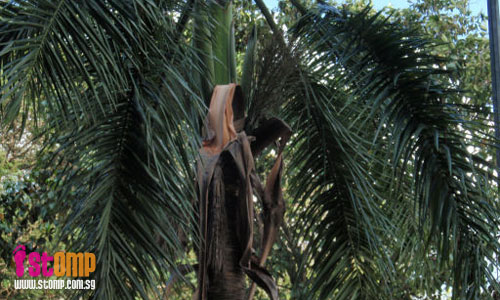
I... I don't know what to say about this particular post.
Tuesday, January 27, 2009
Too much pruning for this plant
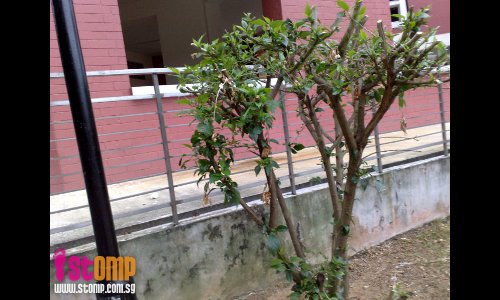
A STOMPer claims that this plant has been pruned too much, till it has become bald, and says it is now an eyesore. He told STOMP:
"This picture of a botak bush (Hibiscus rosa-sinensis) was taken at Bk 287 Bukit Batok East Ave 4. Last month when I passed the block I could see a host of red Hibiscus flowers on this plant which was attractive to all passersby. "Just before the Lunar New Year the Jurong Town Council sent its workers to prune the plants and trees in this estate. After the operation the flowering bushes looked botak as there was excessive pruning. "Yes, pruning needs to be done but why give this bush a botak look which is now an eyesore to the residents during the Lunar New Year."
Labels:
Bukit Batok,
STOMP
Monday, January 26, 2009
Animal cruelty at temple? Tortoises with markings may fall victim to luck-seekers

A STOMPer says these tortoises at Shuang Lin Temple with auspicious Chinese characters painted on their backs might fall victim to luck-seekers at the temple.
Says the STOMPer:
"I was testing my new camera today when I decided to take some photos at Shuang Lin temple.
"There, I found this huge "wishing well" pond where the temple staff had erected a bell underneath a red wooden sign that says 'May your wishes come true'.
"There was also a stone bowl submerged in the water beneath that sign.
"Perched precariously on the edge of this stone bowl, I found two live tortoises with some Chinese characters painted on their poor shells.
"One was 'shou', meaning longevity, while the other wasn't too clear.
"The words stood out from the dull drab green of the tortoises' shells and was very obvious.
"What visitors to the temple would do when they approach this wishing well is to throw a coin at the bell in hopes of hitting it, and if the coin strikes the bell and falls into the stone bowl, the person's wish might come true.
"I'm very worried that with these 'auspicious' characters painted on the tortoises' shells, people might try their luck at striking the tortoises with coins as well.
"There are no other animals in this pool but the tortoises, and the current in the wishing pool was also too strong, thus the poor creatures taking refuge at the stone bowl, which was the only spot for them to rest.
"I think that this is animal cruelty outright and SPCA or the relevant auhorities should be alerted about this matter."

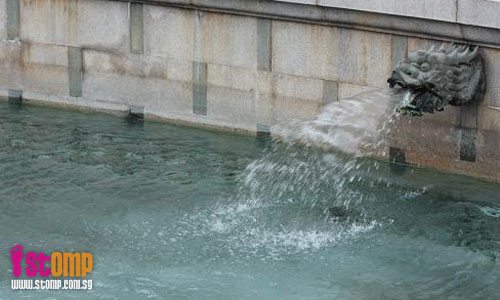
The person who submitted this certainly does have a valid concern. Unfortunately, many people in Singapore appear to have little empathy for other species, and behave as if they are completely ignorant or oblivious to the distress suffered by animals. I won't be surprised if people end up treating the turtles* as targets for their coin projectiles.
*Turtles, not tortoises. Remind me to dedicate a post to the distinction between turtles, tortoises and terrapins one day.
What I am more concerned about though, is with the idiot who painted the shells of these red-eared sliders (Trachemys scripta elegans). I have very little patience with misguided people who carry out certain cruel actions in an attempt to bring good luck, regardless of the ecological impacts, or the suffering that animals are forced to go through.
People seem to easily forget that the shell of a turtle is composed of living, growing tissue. The two turtles in this post appear to be quite young, and at this stage, paint will seriously interfere with the normal growth of their shells, and the periodic shedding of the epidermis of the shell, leading to deformities as the turtle grows. Besides, the opaque coat of paint will definitely interfere with absorption of UV sunlight, which turtles require for healthy growth, especially when they are young. What's worse, it is likely that some of the chemicals in the paint will be absorbed into the turtle's bloodstream. And during the application stage, I'm sure the turtles must have inhaled some of the fumes. I mean, come on, it doesn't hurt to use your brain a little. Would you willingly spend the rest of your life with your back covered with a solid coat of epoxy paint or lacquer, and not expect to run into health problems sometime in the future?
What is it about turtles that makes them such common and unwitting victims of abuse? Seriously, do you really think artificially augmenting a turtle's shell is going to bring you good fortune?
If you think paint is bad, there's another disgusting practice involving the deliberate mutilation and disfiguring of turtle shells that seriously angers me.
Sometimes, wire or twine is deliberately wrapped tightly around the midsection of very young turtles, usually red-eared sliders. As the turtle grows, the wire prevents the shell in the midsection from growing outwards, while the rest of the shell continues to grow unimpeded. The shell becomes contorted and warped, misshapen until it eventually looks like the number '8' when viewed from above. And all because the pronunciation for the number '8' in some Chinese dialects is similar to that of the 发 in 发财 (get rich)! As you can see, the reasoning behind such a practice is stunningly flawless.
Here's a horrifying example:

Who in the right frame of mind would willingly put any living creature through such a procedure, all in the hope of getting rich one day? If I had any power, I would definitely make sure that anyone who did such a thing would be denied the fortune he or she expected, and would instead get to experience such body modification first-hand.
I dare not imagine how the turtle even manages to survive such a procedure; surely the arrangement of the internal organs must be extremely distorted. But then again, turtles are somewhat hardy and durable creatures, and can take an astonishing amount of abuse. But that certainly does not condone such backwards and barbaric behaviour. One would think that in the 21st century, our attitudes should have progressed somewhat.
The wishing pool where these turtles were found is another thing about this article that riles me. It appears that this pool is not meant to have fish or turtles swimming inside in the first place. The person who so irresponsibly dumped the turtles there could have at least picked a pond where they had a decent chance of finding something to eat. I frown upon releasing one's pet turtles, but it wouldn't take a lot of effort to pick a pond with fish, where the turtles could expect handouts from people. Or a more natural-looking pond where they could have a more natural diet. Seriously, what do you expect the turtles to eat in that virtually lifeless pool? And with the strong currents, do you even expect the turtles to be able to survive being swept around all day long? Turtles can and do drown, you know.
So yes, this certainly counts as animal abuse. Not only did the turtles' former owner compromise their health by painting their shells, he or she was irresponsible to abandon them, and to make matters worse, chose to release them in a pool where they probably can't find enough food, have to keep swimming for their lives, and might become moving targets for mean-spirited individuals. What I find ironic was that all these actions were done so that the owner could derive some form of good karma. Good karma my ass, if you'll excuse me for being crude.
Labels:
introduced species,
pets,
reptiles,
stupidity,
threats
Monday Morgue: 26th January 2009
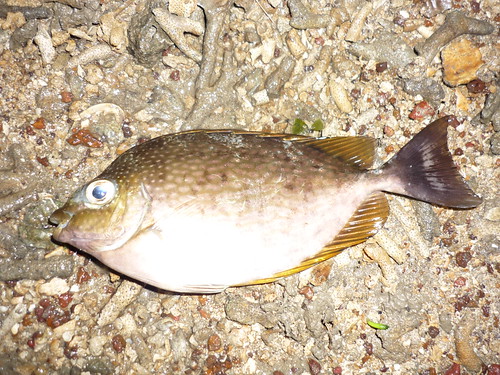
Streaked rabbitfish (Siganus javus)
Beting Bronok, 12th August 2008
Wild Fact Sheets
Fishes of Libong Island
FishBase
Labels:
Beting Bronok,
fish,
monday morgue
Happy Lunar New Year!
It's now officially the Year of the Ox. My friend Chay Hoon sent out an online greeting card featuring a cowfish (Lactoria cornuta).
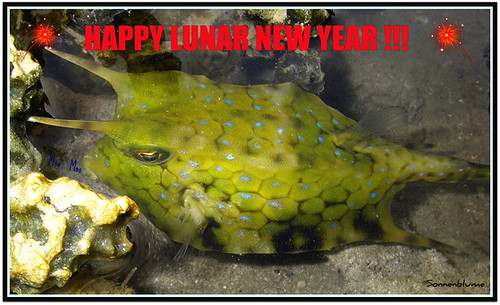
I thought it would be appropriate to do a quick feature on the wild bovines of Southeast Asia:


Left: Gaur (Bos gaurus); Right: Banteng (Bos javanicus);


Left: Kouprey (Bos sauveli); Right: Saola (Pseudoryx nghetinhensis);


Left: Wild water buffalo (Bubalus arnee); Right: Tamaraw (Bubalus mindorensis);


Left: Lowland anoa (Bubalus depressicornis); Right: Mountain anoa (Bubalus quarlesi);
Unfortunately, all of these species are currently threatened with extinction. The gaur is listed as vulnerable, the banteng, wild water buffalo and both lowland and mountain anoa as endangered, while the tamaraw, saola and kouprey are critically endangered; in fact, it is strongly believed that the kouprey might already be extinct. The most important threats include hunting for food and trophies, habitat loss, and hybridisation and disease from domestic cattle and buffalo.
wildcattleconservation.org
Asian Wild Cattle Specialist Group
The gaur is the world's largest species of cattle, with males approaching 2 metres in height, and weighting up to 1000 kilograms. This species is found in forests and woodlands from India and Indochina to Peninsular Malaysia, although a now-extinct Sri Lankan subspecies did survive into historic times. Gaur have been domesticated in parts of northeast India and Myanmar, where they are variously known as gayal or mithun. Interestingly, the first successful birth of a cloned animal belonging to an endangered species was that of a gaur in 2001.
The banteng is slightly smaller than its close relative, and unlike the gaur, displays sexual dimorphism; mature males are dark brown to black, while the cows are much smaller in build, and are a lighter shade of chestnut brown. This species formerly ranged from extreme eastern India and Bangladesh to Indochina, down to Peninsular Malaysia, Borneo, and Java. Domesticated banteng are commonly seen in Bali, where they are appropriately known as Bali cattle. A feral herd about 10,000 strong is also known to exist in Australia's Northern Territory. The banteng was the second endangered species to be cloned successfully, and the first cloned banteng calf was born in 2003.
The kouprey is Cambodia's national animal, and was formerly known from parts of Thailand, Vietnam, and Laos, although its distribution was centred around Cambodia. Another massive animal, almost comparable to the gaur in size, very little is known about this species. In fact, controversy erupted in 2006, when DNA analysis suggested that the kouprey was not in fact a 'real' species, but instead a feral hybrid that resulted from banteng mating with domestic cattle. However, the latest consensus is that the kouprey is indeed a genuine bona fide species in its own right. Unfortunately, it might not matter much in the end, since it has not been seen since 1988. It is likely that the species is now extinct, or nearly so, a victim of hunting for meat and trophies and the violence that has ravaged the region.
The saola is a very special animal; not only does it differ greatly from other bovines in external appearance, it was discovered by western scientists only in 1992. It is an icon for cryptozoologists, seeking to discover species new to science. A shy, solitary inhabitant of the forests of the Annamite mountains, spanning the border between Vietnam and Laos, this is just one of several rare and little-known creatures that have been recently discovered in the mysterious forests of Indochina.
The wild water buffalo also rivals the gaur in size, and holds the record of having the longest horns of any cattle species, with large males possessing horns that can span up to 2 metres. The ancestor of the domestic water buffalo, it is now restricted to scattered locations in India, Nepal, Bhutan, Myanmar, Cambodia, and Thailand, although it was once more widespread throughout South and Southeast Asia, extending west all the way to Mesopotamia. The greatest threat appears to be genetic pollution from the herds of feral and domestic water buffalo which can be found everywhere in the region.
The tamaraw, found only on the island of Mindoro, is the largest native mammal of the Philippines. It is only half the size of the wild water buffalo, although a relative, Bubalus cebuensis, that lived on Cebu during the Pleistocene was even smaller than the tamaraw. This is a clear example of the phenomenon known as insular dwarfism, where large animals stranded on small islands gradually shrink over several generations, hence explaining the existence of pygmy mammoths and elephants, and in this case, pygmy buffalo.

Size comparison of Bubalus cebuensis, tamaraw, and water buffalo.
The lowland anoa and mountain anoa are two more diminutive species of island-dwelling buffalo, though the former is larger than the latter. Both species are solitary, and are found only on the Indonesian island of Sulawesi. True to their name, the lowland anoa is found largely in lowland forests, whereas the mountain anoa appears to prefer forests in hilly and mountainous regions.
There is one final bovine species known from Southeast Asia, although like the kouprey, its status as a species has been the subject of much discussion and debate.
The kting voar (which means spiral-horned ox in Khmer) of the forests of Cambodia is known only from several sets of bizarrely twisted horns. Thought to belong to a new species, it was described in 1994, and named Pseudonovibos spiralis. However, doubt has been cast on the authenticity of the specimens; preliminary investigation through DNA analysis and close examination has revealed that many of these horns are in fact the horns of domestic cattle and buffalo, artificially shaped and manipulated through heating and twisting.
Despite Cambodian legends about the existence of the kting voar, the evidence so far is not in favour of there being another cryptic bovine hiding in the Cambodian forests. Whether or not it does actually exist is dependent on new material being procured and analysed, or of actually finding an entire kting voar, instead of just horns.

Kting voar ("Pseudonovibos spiralis");
So there you have it. Southeast Asia is home to 8 species of wild cattle, although they are all at risk of extinction, and 1 of them, the kouprey, might have already vanished forever. The interesting thing about domesticated bovines in Southeast Asia is that quite a number of species are involved; not only are there the usual domestic cattle, descended from the aurochs (Bos primigenius), there are domesticated gaur and banteng, and hybrids between domestic cattle and the latter 2 species. Not to mention the domestic water buffalo found in abundance throughout rural parts of the region.
Here's wishing everyone a happy Year of the Ox. Is it too much to hope that healthy populations of kouprey in the wild will be rediscovered this year?

I thought it would be appropriate to do a quick feature on the wild bovines of Southeast Asia:


Left: Gaur (Bos gaurus); Right: Banteng (Bos javanicus);


Left: Kouprey (Bos sauveli); Right: Saola (Pseudoryx nghetinhensis);


Left: Wild water buffalo (Bubalus arnee); Right: Tamaraw (Bubalus mindorensis);


Left: Lowland anoa (Bubalus depressicornis); Right: Mountain anoa (Bubalus quarlesi);
Unfortunately, all of these species are currently threatened with extinction. The gaur is listed as vulnerable, the banteng, wild water buffalo and both lowland and mountain anoa as endangered, while the tamaraw, saola and kouprey are critically endangered; in fact, it is strongly believed that the kouprey might already be extinct. The most important threats include hunting for food and trophies, habitat loss, and hybridisation and disease from domestic cattle and buffalo.
wildcattleconservation.org
Asian Wild Cattle Specialist Group
The gaur is the world's largest species of cattle, with males approaching 2 metres in height, and weighting up to 1000 kilograms. This species is found in forests and woodlands from India and Indochina to Peninsular Malaysia, although a now-extinct Sri Lankan subspecies did survive into historic times. Gaur have been domesticated in parts of northeast India and Myanmar, where they are variously known as gayal or mithun. Interestingly, the first successful birth of a cloned animal belonging to an endangered species was that of a gaur in 2001.
The banteng is slightly smaller than its close relative, and unlike the gaur, displays sexual dimorphism; mature males are dark brown to black, while the cows are much smaller in build, and are a lighter shade of chestnut brown. This species formerly ranged from extreme eastern India and Bangladesh to Indochina, down to Peninsular Malaysia, Borneo, and Java. Domesticated banteng are commonly seen in Bali, where they are appropriately known as Bali cattle. A feral herd about 10,000 strong is also known to exist in Australia's Northern Territory. The banteng was the second endangered species to be cloned successfully, and the first cloned banteng calf was born in 2003.
The kouprey is Cambodia's national animal, and was formerly known from parts of Thailand, Vietnam, and Laos, although its distribution was centred around Cambodia. Another massive animal, almost comparable to the gaur in size, very little is known about this species. In fact, controversy erupted in 2006, when DNA analysis suggested that the kouprey was not in fact a 'real' species, but instead a feral hybrid that resulted from banteng mating with domestic cattle. However, the latest consensus is that the kouprey is indeed a genuine bona fide species in its own right. Unfortunately, it might not matter much in the end, since it has not been seen since 1988. It is likely that the species is now extinct, or nearly so, a victim of hunting for meat and trophies and the violence that has ravaged the region.
The saola is a very special animal; not only does it differ greatly from other bovines in external appearance, it was discovered by western scientists only in 1992. It is an icon for cryptozoologists, seeking to discover species new to science. A shy, solitary inhabitant of the forests of the Annamite mountains, spanning the border between Vietnam and Laos, this is just one of several rare and little-known creatures that have been recently discovered in the mysterious forests of Indochina.
The wild water buffalo also rivals the gaur in size, and holds the record of having the longest horns of any cattle species, with large males possessing horns that can span up to 2 metres. The ancestor of the domestic water buffalo, it is now restricted to scattered locations in India, Nepal, Bhutan, Myanmar, Cambodia, and Thailand, although it was once more widespread throughout South and Southeast Asia, extending west all the way to Mesopotamia. The greatest threat appears to be genetic pollution from the herds of feral and domestic water buffalo which can be found everywhere in the region.
The tamaraw, found only on the island of Mindoro, is the largest native mammal of the Philippines. It is only half the size of the wild water buffalo, although a relative, Bubalus cebuensis, that lived on Cebu during the Pleistocene was even smaller than the tamaraw. This is a clear example of the phenomenon known as insular dwarfism, where large animals stranded on small islands gradually shrink over several generations, hence explaining the existence of pygmy mammoths and elephants, and in this case, pygmy buffalo.

Size comparison of Bubalus cebuensis, tamaraw, and water buffalo.
The lowland anoa and mountain anoa are two more diminutive species of island-dwelling buffalo, though the former is larger than the latter. Both species are solitary, and are found only on the Indonesian island of Sulawesi. True to their name, the lowland anoa is found largely in lowland forests, whereas the mountain anoa appears to prefer forests in hilly and mountainous regions.
There is one final bovine species known from Southeast Asia, although like the kouprey, its status as a species has been the subject of much discussion and debate.
The kting voar (which means spiral-horned ox in Khmer) of the forests of Cambodia is known only from several sets of bizarrely twisted horns. Thought to belong to a new species, it was described in 1994, and named Pseudonovibos spiralis. However, doubt has been cast on the authenticity of the specimens; preliminary investigation through DNA analysis and close examination has revealed that many of these horns are in fact the horns of domestic cattle and buffalo, artificially shaped and manipulated through heating and twisting.
Despite Cambodian legends about the existence of the kting voar, the evidence so far is not in favour of there being another cryptic bovine hiding in the Cambodian forests. Whether or not it does actually exist is dependent on new material being procured and analysed, or of actually finding an entire kting voar, instead of just horns.

Kting voar ("Pseudonovibos spiralis");
So there you have it. Southeast Asia is home to 8 species of wild cattle, although they are all at risk of extinction, and 1 of them, the kouprey, might have already vanished forever. The interesting thing about domesticated bovines in Southeast Asia is that quite a number of species are involved; not only are there the usual domestic cattle, descended from the aurochs (Bos primigenius), there are domesticated gaur and banteng, and hybrids between domestic cattle and the latter 2 species. Not to mention the domestic water buffalo found in abundance throughout rural parts of the region.
Here's wishing everyone a happy Year of the Ox. Is it too much to hope that healthy populations of kouprey in the wild will be rediscovered this year?
Saturday, January 24, 2009
Wonder

Many of us would be aware of the New7Wonders of Nature campaign, and that our very own Bukit Timah Nature Reserve is currently still in the running to be nominated as one of the world's so-called top natural wonders.
Frankly, I'm a little ambivalent about all this. It's difficult to pick favourites out of all the countless sites of natural beauty and incalculable conservation and scientific value. While it is likely that this campaign has raised awareness of many lesser-known sites, at the same time, I don't like to draw comparisons between the various nominees. In my opinion, each nominee is a priceless wonder, and the loss and degradation of any of them would be a monumentous tragedy for all of mankind. Similarly, just because countless sites are not in the list, does not mean that they are any less deserving of conservation efforts to ensure that future generations will still be able to revel in their beauty and magnificence.
Through a submission to Tomorrow.sg, I came to know of this blog post denigrating the nomination of Bukit Timah Nature Reserve.
I can't decide if I should laugh or cry when I read this. A jogging track with a couple of misfit monkeys running to be one of the wonders of the world. Against the likes of the Grand Canyon and Niagara Falls, Bukit Timah is like wood shavings of recycled timber from a dead log somewhere in Tasmania.
Trees now botak, so no more shade
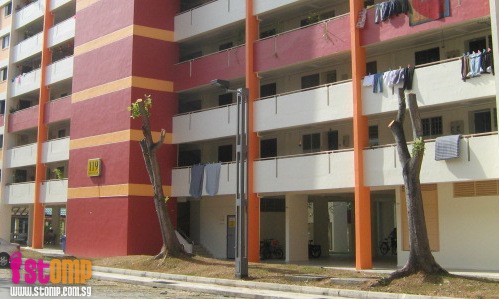
These trees at Lorong Ah Soo, which have been pruned, no longer provides shade, gripes a STOMPer. Patrick told STOMP on Jan 23:
"The trees at Block 119 Lorong Ah Soo has provided good shade and now they are botak (bald). "I don't understand why the town council cut them botak."
Trees on fire at Sungei Tengah

This area in Sungei Tengah caught fire, recounted a STOMPer, who took these pictures of the scene.
ZY told STOMP in an email on Jan 24:
"It was around 6pm when I heard some crackling noises. I went towards the source and realised it was a fire."
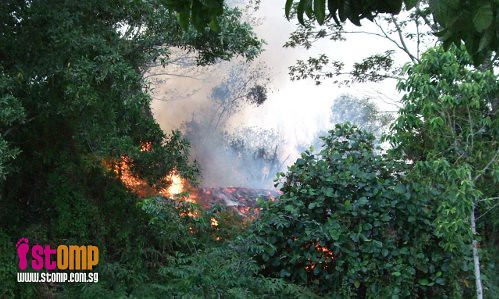
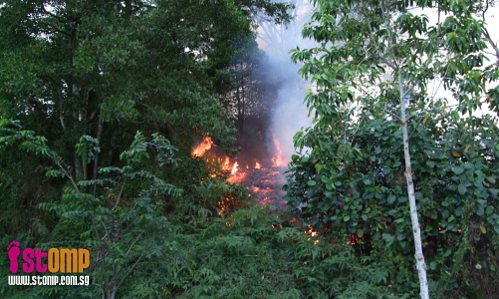
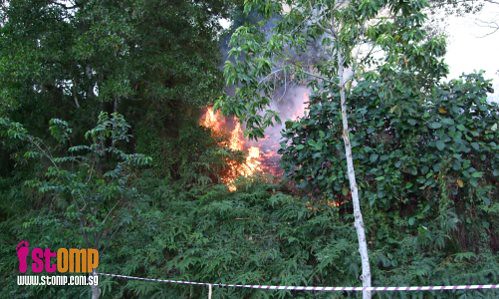

Go here for relevant news articles and related Seen on STOMP posts on bushfires in Singapore
Mandai as dumping ground: Will this pollute our water?

STOMPer Guatamola is concerned about Mandai Road being used as a dumping ground for slag, as it could pollute the water in the catchment area nearby. The STOMPer questions:
"Why is slag being offloaded at Mandai Road?
"Isn't Mandai a water catchment area?
"Will there be a danger of slag seeping into water supply?
"Perhaps the authorities could comment."


I have nothing to comment on this, since this is not my area of expertise at all. Still, the person submitting this post raises a very interesting question. Is there a possibility of industrial waste threatening our already limited water supply?
At this point, I'm reminded of the recent coal ash spill that occurred in the state of Tennessee on December 22nd, and the possible impacts on wildlife in the affected area. If a similar accident should happen, but on a smaller scale, will this threaten any of our few remaining nature areas? It's definitely a question I don't really dare to answer at this point in time.
Subscribe to:
Posts (Atom)
